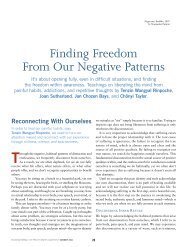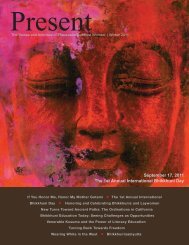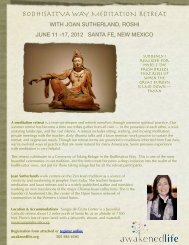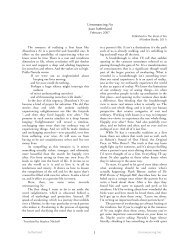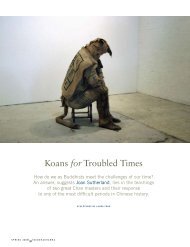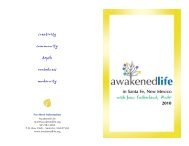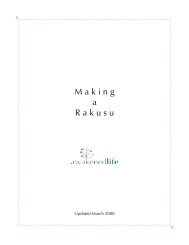On Taking Refuge - Awakened Life
On Taking Refuge - Awakened Life
On Taking Refuge - Awakened Life
Create successful ePaper yourself
Turn your PDF publications into a flip-book with our unique Google optimized e-Paper software.
TAKING REFUGE IN THE BODHISATTVA WAY<br />
Joan Sutherland<br />
Participating in this ceremony is a matter of<br />
expressing your sense of coming home—to your<br />
own awakening, this way of practice, and your<br />
companions on the path. It is an aspiration to<br />
turn your individual life towards that which heals<br />
and encourages all of life.<br />
If you want to take refuge, please speak with<br />
me about it. <strong>Refuge</strong> ceremonies are usually held<br />
during meditation retreats. Here are the things<br />
you’ll do in preparation:<br />
Sewing your rakusu The rakusu connects us to<br />
Shakyamuni Buddha and our ancestors by<br />
representing the robes they wore. You make<br />
your own, and this sewing is itself a form of<br />
extended meditation. Those taking refuge<br />
together often form sewing circles. You give it to<br />
me no later than the beginning of the retreat, and<br />
I write on the underside and return it to you<br />
during the ceremony. A sewing pattern is available;<br />
allow for at least 25 hours of work. If you<br />
absolutely can’t sew your own rakusu, you can<br />
purchase one from Four Gates or Zabu Zabu,<br />
which also has rakusu rings. Most people also<br />
sew a simple envelope for holding their rakusu.<br />
Writing your vows During the ceremony, you<br />
read your understandings of each of the sixteen<br />
vows. These should be brief, personal, and<br />
expressive of the particular rather than the grand<br />
and abstract; they don’t have to be statements for<br />
the ages but should be about how you are<br />
exploring each precept in your life right now. It’s<br />
also important to consider the positive formulation<br />
of each precept, so that “not stealing”<br />
might become “encouraging generosity”.<br />
We hold a series of precepts seminars in the<br />
weeks leading up to the ceremony; if you live in<br />
the area, please plan to attend. If we have a few<br />
people coming from a distance, we’ll arrange a<br />
telephone seminar as well. These discussions are<br />
open to everyone in the community who can<br />
commit to coming consistently, whether you’re<br />
taking vows or not. They’re usually<br />
conversations of depth, beauty, and honesty<br />
about living our lives as fully as we can, with all<br />
the challenges that entails.<br />
Participants also commit to steady work in<br />
the room during this time, and to making a<br />
significant dana offering of time and energy to<br />
the community in the year following the<br />
ceremony.<br />
Choosing your dharma name During the ceremony<br />
you receive a dharma name, which is<br />
written on the back of the rakusu so that it rests<br />
next to your heart. You may ask me to just give<br />
you a name, but usually we collaborate on it. It’s<br />
meant to express your aspirations for your<br />
practice—how you’d like to grow in the Way.<br />
The traditional form is two or three words, one<br />
of them something from the natural world (like<br />
Moon Gate). Sometimes a group taking refuge<br />
together will choose to have part of their name in<br />
common as a kind of clan name (Moon Gate,<br />
Mountain Gate, etc.). Everyone who takes<br />
refuge with <strong>Awakened</strong> <strong>Life</strong> receives the<br />
‘surname’ Wayfarer.<br />
The Three <strong>Refuge</strong> Vows<br />
I take refuge in awakening<br />
I take refuge in the way<br />
I take refuge in my companions<br />
The Three Pure Vows<br />
I vow to do no harm<br />
I vow to do good<br />
I vow to do good for others<br />
The Ten Bodhisattva Vows<br />
1 I vow not to kill<br />
2 I vow not to steal<br />
3 I vow not to misuse sex<br />
4 I vow not to lie<br />
5 I vow not to misuse drugs<br />
6 I vow not to gossip maliciously<br />
7 I vow not to praise myself<br />
at the expense of others<br />
8 I vow not to be stingy<br />
9 I vow not to indulge in anger<br />
10 I vow not to disparage awakening,<br />
the way, or my companions
REFUGE IN THE STORM<br />
Deciding to participate in a ceremony of taking refuge in the bodhisattva way is a deeply personal matter:<br />
It’s not required, so it’s a request that rises from the heart, usually to acknowledge the sense of coming home one<br />
has found in the practice, and the desire to live a life that is more beneficial to oneself and others, a life of greater<br />
kindness.<br />
The realm of the vows is not the world of our ordinary culture, with its emphasis on good boundaries and<br />
cost/benefit ratios. In taking refuge, we admit our own vulnerability and longing. And taking on the precepts is a<br />
beautifully reckless act, in which we make impossible promises and express our willingness to have life act upon<br />
us in ways we won’t be able to control.<br />
We offer ourselves to the world, asking nothing in return, but trusting that if we make this gesture of<br />
intention towards life, life will respond by lifting and carrying us along. To make this gesture is to declare our<br />
love of life, or maybe just whisper the possibility of it. Which is to move from the prison of our own small story<br />
into the fullness of things. Just this one gesture can make all the difference.<br />
Zen asks us to take seriously what it means to save all beings, or to practice good. In other words, as usual it<br />
invites us into a mystery that has no rational answer, but which we must try to answer anyway for our practice to<br />
ripen. As we prepare for the ceremony by writing our own understanding of the vows, we discover, often with a<br />
certain panic, that while we have a powerful impulse towards the vows, we don’t entirely know what they’re<br />
about or what it means to take them on. Then we realize that we’re embarking on a process of deepening and<br />
waiting—of being both curious and patient—learning to love the questions themselves, as Rilke would say. For<br />
the rest of our lives, these vows will be questions, and for the rest of our lives we will be living our way into the<br />
answers.<br />
And so we invoke the spirit of inquiry, exploring deeply what each vow might mean to us, rather than<br />
signing on to a predetermined set of rules for living. In this way we follow Gandhi, who remarked that people<br />
want a lot of rules so they won’t have to be good. We set aside any sense of recipe to go looking for the inherent<br />
goodness in ourselves and the world, and then promise to cultivate it.<br />
<strong>On</strong>e thing it’s important to remember is that the precepts are for yourself, not a weapon to be wielded<br />
against someone else. The precepts aren’t about trying to control others or judge them, but to help with our own<br />
wondering about how to live. If we allow the precepts to work on us in this way, then should we decide to act in<br />
response to something that’s happened, we can be more certain that we’re not acting out of our own wounds—<br />
our desire to “get” somebody or our need to be holier than thou—but with some degree of consciousness and<br />
empathy.<br />
Of course, if we don’t wield the precepts against others, neither should we wield them against ourselves.<br />
<strong>Taking</strong> the precepts is meant to enrich and enlarge our lives, not to narrow them. They aren’t meant to serve a<br />
habit of feeling not-good-enough, or to monitor our every thought and intention. This is a practice of generosity,<br />
for ourselves and others.<br />
The meaning of our vows arises from an exploration of our own sense of integrity, and of our shadow—and<br />
we understand that this is a lifetime practice. It’s a process that’s paradoxical, frustrating, magical, and<br />
sometimes messy. Just like life. We accept that we’ll make mistakes along the way, but that doesn’t stop us from<br />
trying. This is the lotus in the fire, and it’s a process full of our sweat, our tears, our doubts, our generosities, and<br />
sometimes our remorse.<br />
Luckily we have help, because we also take refuge in our practice and our companions. For some people,<br />
this happens the first time they walk into a meditation hall, when they feel they’ve come home. For others, the<br />
sense of homecoming grows slowly over time, with deepening practice, as they become more and more intimate<br />
with their own true nature, and the true nature of the world. For a zen person, this is the ultimate homecoming,<br />
the one no circumstance can ever take away.<br />
What is this ultimate homecoming? The refuge ceremony contains a beautiful quote from Dogen: “The teisho<br />
of the actual body is the harbor and the weir. This is the most important thing in the world.” Teisho refers to a<br />
dharma talk and literally means “presentation of the shout”. The shout of eternity, the sound of the place we come<br />
home to. Our ancestor Prajnatara said, “I am always reciting millions and millions of sutras.” We recite with our<br />
words, our silences, our eating breakfast and our meditation. Everything is constantly presenting the shout of<br />
eternity in its own unique way : this redwood, that squirrel, the traffic in the distance. Listen, listen. The voice of<br />
the stars, the voice of the earthworms, right here. These are the actual bodies, and this is the refuge.



